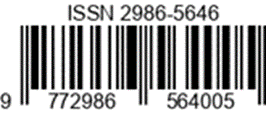Analysis of Pasombahan Kreasi Dance Movements in Bangkinang Sub-District Kampar Regency City, Riau Province
DOI:
https://doi.org/10.24036/ag.v2i1.82Keywords:
Analis, gerak, Tari Pasombahan kreasiAbstract
The purpose of this study was to find and describe the Pasombahan Kreasi Dance Motion Analysis in Bangkinang Kota District, Kampar Regency, Riau Province. This type of research is qualitative, using descriptive methods. The instrument in this research is the researcher himself and is assisted by supporting instruments such as stationery, flash discs, and mobile phones. Data collection techniques are done through literature study, observation, interviews, and documentation. The steps in analyzing data include data reduction, data presentation, and conclusion drawing. The results showed that the movements in Pasombahan Dance consisted of four names for various movements, namely sombah, punte tali bowuok, klenjek, and sendeng. But in each part of the movement, there are several more parts with a total of 17 motion motifs, but with different counts. Pasombahan dance analysis is seen from the perspectives of space, time, and energy. The element of space in each Pasombahan dance uses a dominant straight line and a right diagonal line. The dominant volume in Pasombahan Dance is medium and small, facing towards the front and towards the front right diagonal. The level contained in the Pasombahan Dance is medium and high in each motion motif, with the focus of the head towards the front and towards the hand movements. The time aspect of this Pasombahan dance has a slow tempo in the sombah movement, while the rest uses a fast tempo. As for the energy element, the ending increases the intensity.
References
Ekaputri, M., & Darmawati, D. (2020). Tinjauan Koreografi Tari Silek Paarakan Di Jorong Kampung Surau Kenegarian Gunung Selasih Kecamatan Pulau Punjung Kabupaten Dharmasraya. Jurnal Sendratasik, 9(4), 127-134.
Indrayuda. (2012). Eksistensi Tari Minangkabau. Padang : UNP Press.
Indrayuda. (2014). Tari Sebagai Budaya dan Pengetahuan. Padang :UNP Press
Indrayuda. (2019). Mengekspresikan Tari Tradisi melalui pengembangan gerak dari aspek tenaga, ruang, dan waktu. E-jurnal Sendratasik
Kaelan. (2012). Metode Penelitian Kualitatif interdisipliner. Yogyakarta: Paradigma
Maibur, L. P., & Mansyur, H. (2022). Analisis Gerak Tari Piriang Rantak Kudo di Pauh IX Lapau Munggu Kecamatan Kuranji Kota Padang. Jurnal Sendratasik, 11(3), 467-475.
Meizul Ofriananda. (2016). Gaya Tari Pasombahan Kreasi di Kecamatan Bangkinang Kota Kabupaten Kampar. “(Skripsi)”. Padang : UNP
Mujiati, H. (2013). Analisis dan Perancangan Sistem Informasi Stok Obat pada Apotek Arjowinangun. Speed-Sentra Penelitian Engineering dan Edukasi, 12(1).
Murgiyanto, Sal. (1983). Koreografi Pengetahuan Dasar Komposisi Tari. BP Departemen. Pendidikan dan Kebudayaan
Murgiyanto, Sal. (1983). Koreografi. Jakarta: Proyek pengadaan buku pendidikan menengah kejuruan.
Nerosti, (2019). Mertafora Tari Dalam Pendidikan. Padang:Sukabina Press.
Sari, N. P., & Darmawati, D. (2019). Analisis Gerak Tari Ulu Ambek Di Nagari Sintuk Kecamatan Sintuk Toboh Gadang Kabupaten Padang Pariaman: Aspek Ruang, Waktu, Dan Tenaga. Jurnal Sendratasik, 8(1), 1-8.
Sugiyono, (2017). Metode Penelitian Kualitatif .Yogyakarta: Alfabeta.
Ulfa, N. A., & Desfiarni, D. (2022)..Analisis.Gerak.Tari.Rangguk.Desa.Seberang Kecamatan Pesisir Bukit Kota Sungai Penuh. Jurnal Sendratasik, 11(4), 476-485.
Yolanda, N. P., & Susmiarti, S. (2020). Struktur Gerak Tari Tampuruang Di Nagari Batu Manjulua Kecamatan Kupitan Kabupaten Sijunjung Provinsi Sumatera Barat. Jurnal Sendratasik, 10(1), 357-363.
Downloads
Published
Issue
Section
License
Copyright (c) 2023 Laras Tri Andini Laras Tri Andini, Darmawati

This work is licensed under a Creative Commons Attribution-NonCommercial-ShareAlike 4.0 International License.











